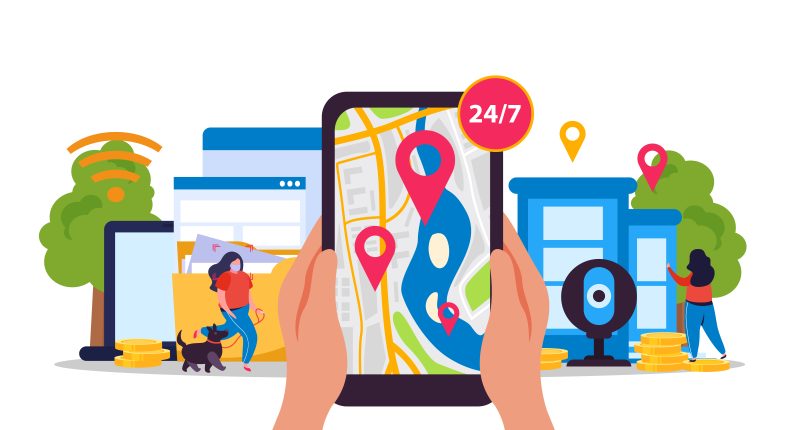Location-based services are transforming the retail sector, offering new ways to improve customer satisfaction and streamline operations. The market for these services is rapidly expanding, with a projected value of $129.71 billion by 2032.
With technological advancements and reliance on data-driven strategies, location-based retail can become even more dynamic and impactful.
Benefits of Location-Based Services in Retail
Location-based services offer numerous advantages for retailers. These services use precise location data to create more targeted and efficient operations.
Improved delivery accuracy
Location-based services provide real-time location tracking, enabling retailers to optimize delivery routes and reduce delays. Accurate location data minimizes errors, ensuring packages reach the correct destinations on time.
Location-based tools can streamline the checkout process and improve delivery accuracy. For example, Amazon uses location-based services to provide real-time updates on delivery progress and estimated arrival times, reducing missed deliveries.
This is extremely important since most consumers highly value delivery accuracy and timeliness. Sixty-nine percent of consumers are less likely to support a brand if they can’t get their purchased items within two days. Retailers should invest in advanced GPS tracking systems to enhance delivery logistics and reduce operational costs.
Personalized shopping experiences
Location-based services enable retailers to offer personalized promotions and recommendations based on customers’ locations. Through technologies like beacon-based marketing, retailers can send targeted messages to customers’ smartphones as they move through different store sections.
Geo-targeted advertising ensures relevant offers reach the right audience, increasing conversion rates. For instance, Starbucks uses geofencing to send targeted promotions to customers’ smartphones when they are near a store, boosting foot traffic.
This approach informs customers about ongoing promotions and guides them to specific products, making their shopping journey more efficient and enjoyable. Fifty-three percent of shoppers visited a retailer after receiving a location-based alert. This finding demonstrates the potential of LBS in driving foot traffic and sales.
Efficient inventory management
Location-based services are also revolutionizing inventory management. By monitoring the movement of products within a store, retailers can optimize stock levels and reduce instances of out-of-stock items. This leads to better inventory turnover and minimizes the cost associated with excess inventory.
Additionally, LBS can assist in identifying popular items in specific locations, allowing retailers to allocate resources more effectively. For example, retailers can adjust their inventory distribution if a particular product is frequently purchased in one store but not another.
Challenges in Implementing Location-Based Services
Despite the benefits, implementing location-based services in retail comes with challenges. Here are some of them:
Data privacy concerns
Collecting and storing location data raises significant privacy issues, requiring strict compliance with data protection regulations. Retailers must be transparent with customers about data usage and obtain explicit consent. Implementing robust security measures is mandatory to protect sensitive location information.
Ensure compliance with regulations like GDPR by updating privacy policies and obtaining explicit customer consent for data collection.
Integration with existing systems
Integrating location-based services with existing retail systems can be complex and resource-intensive. Ensuring compatibility and seamless operation across various platforms requires careful planning and execution. Retailers may need to invest in new technologies and staff training to effectively implement location-based services.
For example, Walmart’s integration of in-store navigation with its mobile app required significant IT investments and staff training. However, these initial investments improved customer satisfaction.
If you plan on getting a location-based API, conduct a thorough technology audit. This process will help identify integration points and potential challenges before implementing new location-based services.
Emerging Trends in Location-Based Services
The landscape of location-based services is continuously evolving, with market trends and innovations shaping the retail landscape.
AI and machine learning
Machine learning and artificial intelligence (AI) enhance the capabilities of location-based services, enabling more accurate predictions and personalized experiences. These technologies can analyze tons of data to pinpoint patterns and trends, providing valuable insights for retailers. AI-driven location-based services can automate inventory management and customer service tasks, improving operational efficiency.
For example, Sephora uses AI to analyze customer location data and preferences, providing personalized recommendations and improving in-store experiences. This has helped the beauty company grow. Estimates show it’s likely to hit net sales of $3.6 billion this year thanks to digital innovations.
Integration with augmented reality
Stores can use augmented reality (AR) with location-based services to create immersive shopping experiences. AR-powered navigation helps customers locate products in-store, while virtual try-ons enhance online shopping.
Retailers can use AR to showcase products in real-world settings, boosting customer engagement and satisfaction. IKEA’s AR app, for instance, allows customers to visualize furniture in their households before making a purchase.
Tools to Optimize Location-Based Services
Various tools and technologies can help retailers optimize their use of location-based services, enhancing efficiency and customer satisfaction.
Radar’s address autocomplete API
Radar’s address autocomplete API provides accurate and efficient location services, streamlining checkout. This tool helps retailers reduce cart abandonment by simplifying customer address entry. Using such tools can improve delivery accuracy and enhance the overall customer experience. E-commerce websites that have integrated address autocomplete features see a reduction in cart abandonment and an increase in customer satisfaction.
Implement address autocomplete features on checkout pages to simplify the process and reduce errors.
Advanced analytics platforms
Advanced analytics platforms enable retailers to gather and analyze location data for better decision-making. These platforms can analyze data and provide actionable insights into customer preferences and trends. Utilizing analytics can help retailers improve their marketing strategies and customer engagement.
Most stores use advanced analytics to understand customer foot traffic patterns, optimizing layouts and product placements. Invest in analytics platforms that process location data and provide actionable insights to improve store operations and marketing efforts.
Shaping the Retail Landscape
Location-based services are set to transform the retail industry, offering numerous benefits such as improved delivery accuracy and personalized shopping experiences. However, retailers must address challenges like data privacy and system integration to benefit from these services.
Retailers can enhance their operations and customer satisfaction by adopting advanced technologies and tools. Staying ahead of these emerging trends in the retail industry will be crucial for retailers. It will help them remain competitive in the evolving landscape of location-based services.





